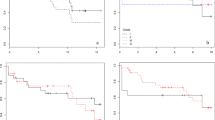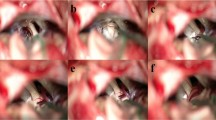Abstract
Background
Hydrocephalus is a common complication of posterior fossa surgery, but its real incidence after microvascular decompression (MVD) for idiopathic trigeminal neuralgia (TN) still remains unclear. The aim of this study was to focus on the potential association between MVD and hydrocephalus as a surgery-related complication.
Methods
All patients who underwent MVD procedure for idiopathic TN at our institute between 2009 and 2014 were reviewed to search for early or late postoperative hydrocephalus.
Results
There were 259 consecutive patients affected by idiopathic TN who underwent MVD procedure at our institution between 2009 and 2014 (113 men, 146 women; mean age 59 years, range 30–87 years; mean follow-up 40.92 months, range 8–48 months). Nine patients (3.47 %) developed communicating hydrocephalus after hospital discharge and underwent standard ventriculo-peritoneal shunt. No cases of acute hydrocephalus were noticed.
Conclusions
Our study suggests that late communicating hydrocephalus may be an underrated potential long-term complication of MVD surgery.
Similar content being viewed by others

References
Albeck MJ, Skak C, Nielsen PR, Olsen KS, Børgesen SE, Gjerris F (1998) Age dependency of resistance to cerebrospinal fluid outflow. J Neurosurg 89:275–278
Barker FG 2nd, Jannetta PJ, Bissonette DJ, Larkins MV, Jho HD (1996) The long-term outcome of microvascular decompression for trigeminal neuralgia. N Engl J Med 334:1077–1083
Børgesen SE (1984) Conductance to outflow of CSF in normal pressure hydrocephalus. Acta Neurochir (Wien) 71(1–2):1–45
Broggi G, Broggi M, Ferroli P, Franzini A (2012) Surgical technique for trigeminal microvascular decompression. Acta Neurochir (Wien) 154:1089–1095
Conn HO (2011) Normal pressure hydrocephalus (NPH): more about NPH by a physician who is the patient. Clin Med (Lond) 11(2):162–5
Dubey A, Sung WS, Shaya M, Patwardhan R, Willis B, Smith D, Nanda A (2009) Complications of posterior cranial fossa surgery—an institutional experience of 500 patients. Surg Neurol 72(4):369–375
Ekstedt J (1978) CSF hydrodynamic studies in man. Normal hydrodynamic variables related to CSF pressure and flow. J Neurol Neurosurg Psychiatry 41:345–353
Hanakita J, Kondo A (1988) Serious complications of microvascular decompression operations for trigeminal neuralgia and hemifacial spasm. Neurosurgery 22(2):348–52
Legnani FG, Saladino A, Casali C, Vetrano IG, Varisco M, Mattei L, Prada F, Perin A, Mangraviti A, Solero CL, DiMeco F (2013) Craniotomy vs. craniectomy for posterior fossa tumors: a prospective study to evaluate complications after surgery. Acta Neurochir (Wien) 155(12):2281–2286
McLaughlin MR, Jannetta PJ, Clyde BL, Subach BR, Comey CH, Resnick DK (1999) Microvascular decompression of cranial nerves: lesson learned after 4400 operations. J Neurosurg 90(1):1–8
Olson S, Atkinson L, Weidmann M (2005) Microvascular decompression for trigeminal neuralgia: recurrences and complications. J Clin Neurosci 12(7):787–789
Tans JTJ, Poortvliet DCJ (1989) Relationship between compliance and resistance to outflow of CSF in adult hydrocephalus. J Neurosurg 71:59–62
Xia L, Zhong J, Zhu J, Wang YN, Dou NN, Liu MX, Visocchi M, Li ST (2014) Effectiveness and safety of microvascular decompression surgery for treatment of trigeminal neuralgia: a systematic review. J Craniofac Surg 25(4):1413–1417
Zhang H, Lei D, You C, Mao BY, Wu B, Fang Y (2013) The long-term outcome predictors of pure microvascular decompression for primary trigeminal neuralgia. World Neurosurg 79(5–6):756–762
Contributors
F.M., G.T., V.L., G.K.I.L., V.N. and A.F. contributed to the conception and design of the article, to the data acquisition, analysis and interpretation. All the authors were involved in critically drafting/revising the article for important intellectual content. Finally, they all gave final approval of the version to be published.
Author information
Authors and Affiliations
Corresponding author
Ethics declarations
Competing interests
None.
Funding
No funding was received for this research.
Conflict of interest
None.
Ethical approval
All procedures performed in studies involving human participants were in accordance with the ethical standards of the institutional and/or national research committee and with the 1964 Helsinki declaration and its later amendments or comparable ethical standards.
For this type of study formal consent is not required
Informed consent
Informed consent was obtained from all individual participants included in the study.
Additional information
Comments
The aim of the authors was to find out whether hydrocephalus, which not infrequently can be seen as a complication to posterior fossa surgery, is a consequence of the procedure per se, or whether it is caused by a combination of the condition and the procedure. As more “bloody” procedures, where elements of blood, tumour tissue, etc., may contaminate the CSF and thus contribute to the development of hydrocephalus, the authors have chosen to study one of the “purest"” procedures (and condition) in the posterior fossa: microvascular decompression (MVD) for idiopathic trigeminal neuralgia (TN). They analysed retrospectively the results of 259 patients who underwent an MVD procedure for idiopathic TN in their institution during a 5-year period. None of the procedures was complicated by acute hydrocephalus, but nine patients (3.47 %) developed communicating hydrocephalus requiring ventriculo-peritoneal shunting after they were discharged from the hospital, within a postoperative range of 10–183 (mean 96) days.
In my view, this is an original approach to the problem—I cannot find any other similar publications. Although one can never rule out intraoperative extravasation of blood during this procedure as a cause, I believe the authors have provided relatively strong indications that the MVD procedure in itself may yield hydrocephalus, perhaps by an acute altering of the hydrodynamic conditions.
Knut Wester
Bergen, Norway
Rights and permissions
About this article
Cite this article
Muratorio, F., Tringali, G., Levi, V. et al. Hydrocephalus: an underrated long-term complication of microvascular decompression for trigeminal neuralgia. A single institute experience. Acta Neurochir 158, 2203–2206 (2016). https://doi.org/10.1007/s00701-016-2911-4
Received:
Accepted:
Published:
Issue Date:
DOI: https://doi.org/10.1007/s00701-016-2911-4



